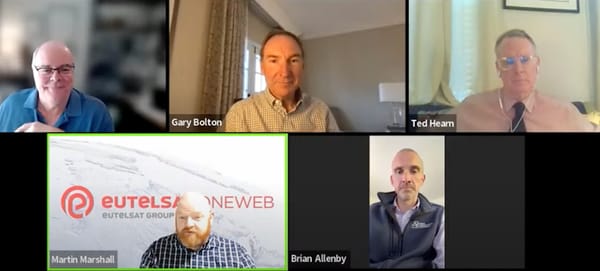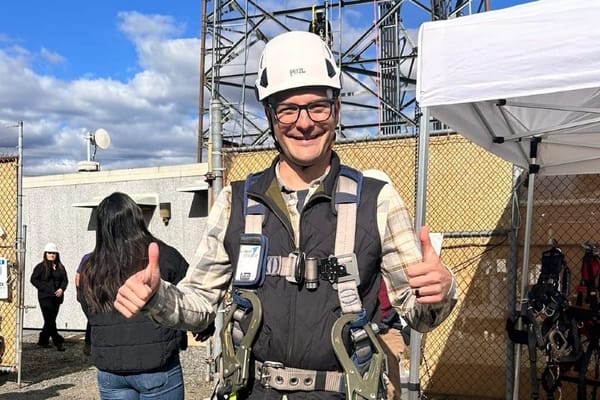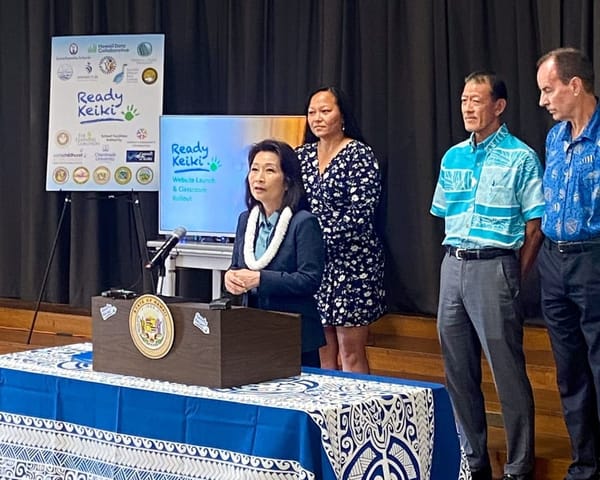Bryan Darr: Federal Broadband Funding is Available for Local Governments
Ookla can help your community get the funding you need to provide access for all to the digital economy.
Broadband Breakfast

Local governments, the clock is ticking.
The Infrastructure Investment and Jobs Act set billions of dollars out on the infrastructure buffet table for local governments in the United States and there are more guests invited to the party than ever before.
This funding is almost certainly a once-in-a-lifetime opportunity to connect your community and provide access for all to the digital economy. The question is: will you be at the front or the back of the line?
Ookla can help you. This article is designed to give you the information you need to get started on the path toward getting the funding you need for your communities.
Look to your state for funding
Historically, broadband funding has had a very top-down approach.
The Federal Communications Commission has held almost all the power to determine where federal broadband infrastructure dollars have been spent. But for the first time, state governments will have an active role in guiding these decisions.
The Infrastructure Investment and Jobs Act directs $65 billion to improving broadband connectivity across the U.S., with $42.45 billion earmarked for building new infrastructure.
Once the initial FCC map has been released, each state that has declared their intent to participate through National Telecommunications and Information Administration will be provided a minimum $100 million to get the process started (U.S. territories will split an additional $100 million).
Much of the remaining $22 billion will target affordability, but more on that later.
The race for resources will be officially off and running.
Following this initial disbursement, there will be roughly $37 billion more to be awarded from the IIJA alone.
Many states are still sitting on billions of dollars from the American Rescue Plan Acts and broadband is an allowable expenditure for these remaining stimulus dollars.
Add to that the long running connectivity programs such as Connect America Fund, Rural Digital Opportunity Fund, Mobility Fund and the upcoming Rural 5G Fund, and all those programs combined approach $100 billion over the next decade.
Plan ahead to increase your competitiveness
Past programs have provided funding without setting proper expectations on results. More emphasis is now being placed on planning.
With a focus on estimated cost per service address, network design takes a front seat to ensure these resources are spent efficiently and state officials will be allowed to use up to five percent of this for mapping, designing, and cost estimation.
Most states are already planning, or already building, their own broadband availability maps. But if you have connectivity issues in your community, it’s time to make it known to those who will be responsible for directing funds and deciding which communities will see investment and which will not.
Ookla helped Loudoun County, Virginia secure $17 million
We have experience helping local governments navigate this challenging planning process.
When FCC Form 477 broadband availability data showed that nearly 100% of Loudoun residents have access to what the FCC defines as broadband (25 Megabits per second (Mbps) download, 3 Mbps upload), this was inconsistent with the connectivity experiences of county residents.
So the Loudoun Broadband Alliance chose to use Ookla Speedtest Intelligence® to create an accurate and reliable broadband access mapping methodology using real-world network performance data.
With this data, LBA identified a large number of unserved households in contrast to FCC data which showed them as served. Loudoun County was subsequently awarded over $17 million of funding to help eliminate the broadband gap.
Keep in mind that the maps will never be finished. They will change and evolve as the networks in your area grow.
Funded projects will need to be monitored for compliance and older networks will need to be watched for signs of deterioration. Everyone will need to keep an eye on progress, measure successes, and have the data to act early when projects go off track.
Acadiana, Louisiana used Speedtest data to win $30 million
With Speedtest data, the Acadiana Planning Commission was able to successfully challenge FCC maps on over 900 out of approximately 1,000 census blocks.
The APC applied for funding through the NTIA Broadband Infrastructure Program, which made $288 million in funding available to help close the digital divide in the U.S.. There were over 230 applicants, and only 13 grants were awarded.
Vice President Kamala Harris visited Acadiana in March to announce that the APC had been awarded a $30 million grant that will fund high-speed internet in 11 rural Acadiana communities.
Think big! Broadband funding is available for more than just infrastructure
Accessibility to broadband requires at least four components: infrastructure, affordability, equipment, and knowledge. The lack of any one of these means an individual does not have access to today’s digital economy.
Much of the focus has been on the lack of infrastructure in many rural communities, but infrastructure is the absolutely essential piece for anyone in any community to get connected.
The second component, affordability, often drives the last two requirements as people who cannot afford internet service often cannot afford the necessary equipment and, therefore, are less likely to have developed the knowledge to use it.
Tracking both of these two primary elements is key to understanding the digital divide.
You might qualify for funding in more than one of these four areas. For example, over $14 billion in a new Affordable Connectivity Program is included in the broadband portion of the IIJA.
Remaining funds include $2.75 billion for the Digital Equity Grant Program and the $2 billion Tribal Broadband Connectivity Program, as well as two more programs that will assist the USDA improve the internet in agricultural communities.
Agencies and local governments should work together
Cities should be coordinating with counties and other government entities within the same region — but someone needs to be in charge.
If your local government does not have an individual charged with coordinating all these efforts, there is bound to be duplication of efforts, wasted resources, stagnation of ideas, or all of the above.
Whether this person reports directly to the chief technology officer, chief information officer, mayor, or city manager, their purpose is to understand what all departments are doing in the space and coordinate discussions, grant opportunities, and overlapping initiatives to make sure that departments aren’t working at cross purposes.
Non-profits, community activists, and local corporations all have a stake in the success of these efforts.
Traffic problems won’t suddenly end at the municipal boundary. Improving traffic on one side of the line may create more problems on the other side. Working together with your neighbors is just as important as working with internal departments. The same can be said of both fixed and wireless broadband infrastructure.
Dig-once projects will score extra points in the competition to have projects selected.
Broadband is only part of the $1.2 billion infrastructure law. Roads, bridges, ports, and rail have billions of dedicated dollars as well.
Digging a new trench for a clean water system? Coordinate with the project to include conduit and fiber and your efficient use of taxpayer funds will likely be rewarded.
Consider funding for multiple technologies
As great as it might be to provide every service address in the country with a fiber connection, it may not make economic sense in some places.
But an important detail was clearly stated in the legislation that recognizes a technology neutral stance on solutions.
The rules are not yet complete on how the FCC and NTIA will award the IIJA funds and contend with challenges to their findings, but there are certainly far fewer restrictions on the ARPA funds that are already disbursed to the states. Many connectivity projects are already underway whether through infrastructure development, equipment distribution, or subsidies for affordable service.
Wireless services can get people connected much faster and there are several forms.
Traditional mobile operators are rolling out 5G and Fixed Wireless Access in some areas that can directly compete with traditional fixed services. Wireless internet service providers have launched coverage to homes and businesses that previously had satellite as their only option.
Some municipalities and school systems have launched private 4G LTE networks to connect underserved areas in their communities. And municipal Wi-Fi can still be an important part of an overall solution.
A portion of families may never find subscribing to a fixed network practical, but wireless services allow for easier movement and some don’t even require a residence. Understanding wireless network availability and performance across your jurisdiction is just as important as planning a fiber network.
And here’s a bonus — cellular and other transmission sites need fiber for any new 5G cell site. So if you know where your wireless networks need additional infrastructure, you can plan for places in the network to offer them accessible fiber connections.
If your state still has ARPA funds available, you still have an opportunity to make improvements and learn more about connectivity issues so you are better able to make your case for the IIJA funds as they begin to flow.
Ookla can provide you with the data you need to be competitive for federal funding
It has been said for years that broadband is the fourth utility.
Local governments have spent a lot of their resources managing the first three: water, gas, and electricity.
If any of those become unavailable, even for a brief period of time, their citizens will make their unhappiness known. Resiliency of these services will play a part in how elected officials are judged, whether the local government supplies these services or just manages an external provider.
If you serve in local government, you should anticipate the same expectations going forward for broadband in your community.
The internet has become vital to the way we live our lives, and access to it dictates much of our success both as residents and businesses. Recognizing connectivity as a critical service may have been a consequence of a pandemic, but that change in thinking is here to stay.
That’s why Ookla is here to help you learn more about the connectivity in your area.
We’ve already helped local governments secure tens of millions of dollars in federal funding in Loudoun County, Virginia and Acadiana, Louisiana. We are also working with state broadband offices as well as municipalities to help them gain visibility into network availability and performance.
If you want your community to take advantage of the billions pouring into improving connectivity, get in line before it’s too late.
Drawn from billions of Speedtest results, Ookla’s Broadband Performance Dataset provides governments, regulators, ISPs, and mobile operators with insights about the state of fixed networks and broadband accessibility. The Broadband Performance Dataset helps you identify unserved and underserved areas, prioritize investment opportunities to improve access to broadband, challenge funding decisions, and secure grants.
To learn more about the Broadband Performance Dataset, Speedtest Intelligence, and other solutions for your state and/or local governments, please contact us.
Bryan Darr is the Vice President of Smart Communities at Ookla. He coordinates Ookla’s outreach to local, state and federal governments and serves on CTIA’s Smart Cities Business & Technology Working Group. This piece was first published on Ookla’s web site, and is reprinted with permission.
Broadband Breakfast accepts commentary from informed observers of the broadband scene. Please send pieces to commentary@breakfast.media. The views expressed in Expert Opinion pieces do not necessarily reflect the views of Broadband Breakfast and Breakfast Media LLC.







